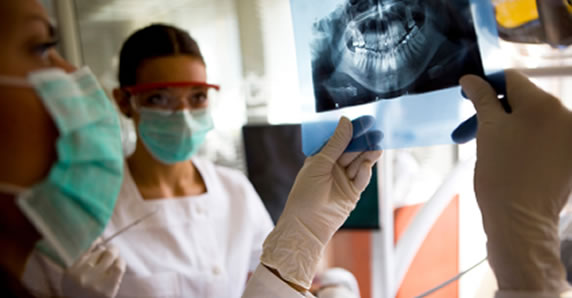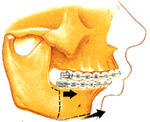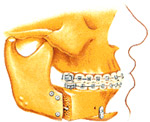Orthognathic Surgery

Orthognathic surgery involves correcting jaws that do not meet correctly, or teeth that do not align properly. In most cases, teeth are straightened, or properly aligned, with orthodontics before corrective jaw surgery can be performed to reposition misaligned jaws. This not only improves facial appearance, but ensures that teeth meet correctly and function properly. Orthognathic surgery allows for the repositioning of teeth and facial bones to create a jaw that works and functions properly, and has a more balanced appearance. State-of-the-art technology, including X-ray and computer imaging, allows the patient to see projected results before surgery is performed.

Before Surgery

After Surgery
Orthognathic surgery can address a host of issues, including:
- Protruding jaw or chin
- Elongated chin
- Deficient chin
- "Gummy" smile
- Open bite (space between upper and lower teeth)
- Difficulty in chewing, biting or swallowing
- Chronic jaw pain (TMD)
- Speech problems
Types of Orthognathic Surgery
There are a number of types of orthognathic surgery. They include:
Bilateral Saggital Split Osteotomy (BSSO)
An osteotomy is any procedure in which a bone is cut in order to reposition it or change its length. A bilateral sagittal split osteotomy (BSSO) is a surgery aimed at correcting a lower jawbone that is too short or too long. This procedure can improve functions such as biting or speaking, and can radically improve a person's appearance. Prior to the procedure, an orthodontist applies dental braces to ensure the teeth will be properly aligned following surgery. Once the teeth are aligned, the patient is ready for the BSSO.
During the surgery, incisions are made below the teeth to expose the jaw. The jawbone is then carefully cut on both sides, and moved forward or backward to an ideal position. Plates and screws are then applied to allow bone to grow and heal naturally. While many patients can achieve an ideal facial structure with BSSO alone, others choose to undergo an additional chin procedure called genioplasty.
Genioplasty
When a chin is weak, misaligned or disproportionate to the rest of the face, a genioplasty may be performed. This procedure takes one of two forms: sliding the chinbone forward or inserting an implant. Prior to a "sliding genioplasty," an incision is made behind the lower lip. The chinbone is then cut and moved into the ideal position. Plates and screws are inserted to allow bone to grow and heal naturally.
Depending on their cosmetic needs, many patients benefit from chin implants. During the procedure, an implant made of silicone or another soft, flexible material is inserted into the chin through a small incision. The implant may be placed into a pocket, or secured to the bone with screws for long-lasting results. This procedure generally takes about 30 minutes to perform, and patients are usually able to return to work and other regular activities the next day.
Many patients opt for a genioplasty following certain other surgeries. This procedure is commonly used to enhance the results of a jaw lengthening procedure or to improve facial balance following a nose surgery.
LeFort I, II and III Osteotomies
Unlike BSSO surgery, LeFort procedures aim to correct facial irregularities by moving the upper jaw and/or the midface. LeFort surgery, depending on the type, can correct a host of problems, including a face that appears too long or too short, a "gummy" smile, and over- or underbites.
There are three types of LeFort procedures:
LeFort I osteotomy
The most common of the LeFort procedures, this procedure corrects problems such as a "gummy" smile, long face or overbite by repositioning the upper jaw. Depending on the patient's needs, the bone of the upper jaw is repositioned, and/or part of the jawbone itself is removed. Plates and screws are then applied to allow bone to grow and heal naturally.
LeFort II osteotomy
When the midface has a deformity, this procedure may be performed. During this surgery, the upper jaw, as well as some of the facial bone, is repositioned. LeFort II osteotomies aim to correct growth abnormalities in the midface, and problems such as sleep apnea or malocclusions.
LeFort III osteotomy
This procedure is quite similar to a LeFort II osteotomy, except more facial bone has to be repositioned. It is one of the most common procedures used to treat midfacial hypoplasia, which causes the midface and eye sockets to not develop fully, resulting in a bug-eyed appearance and an underbite.

